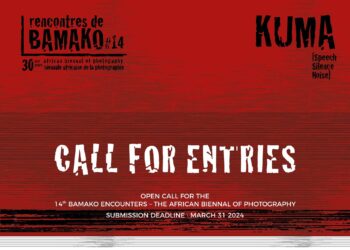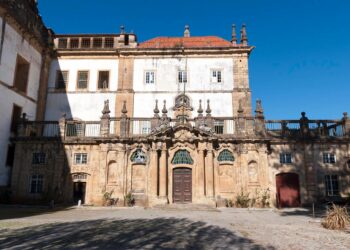“Understood in the context of the 35th Bienal de São Paulo these choreographies of returns, movements of the impossible, are as temporalities that are realised in episteme at each movement that seeks to escape the rigidity of this world torn apart by the daily life of the rites and practices of total violence and which make the idea of a full and just life an impossible occurrence. An unattainable horizon for at least five centuries, for the same and increasingly numerous wretched of the earth? A world against which, in the end, attempts are made, as unavoidable as they are improbable, to wriggle and escape, refuse, confront, reverse, and repair the consequences of those very contexts that make the lives of some more impossible than the lives of others.” the curators state in the introductory text to the impressive 350-page catalogue which accompanies the Bienal.
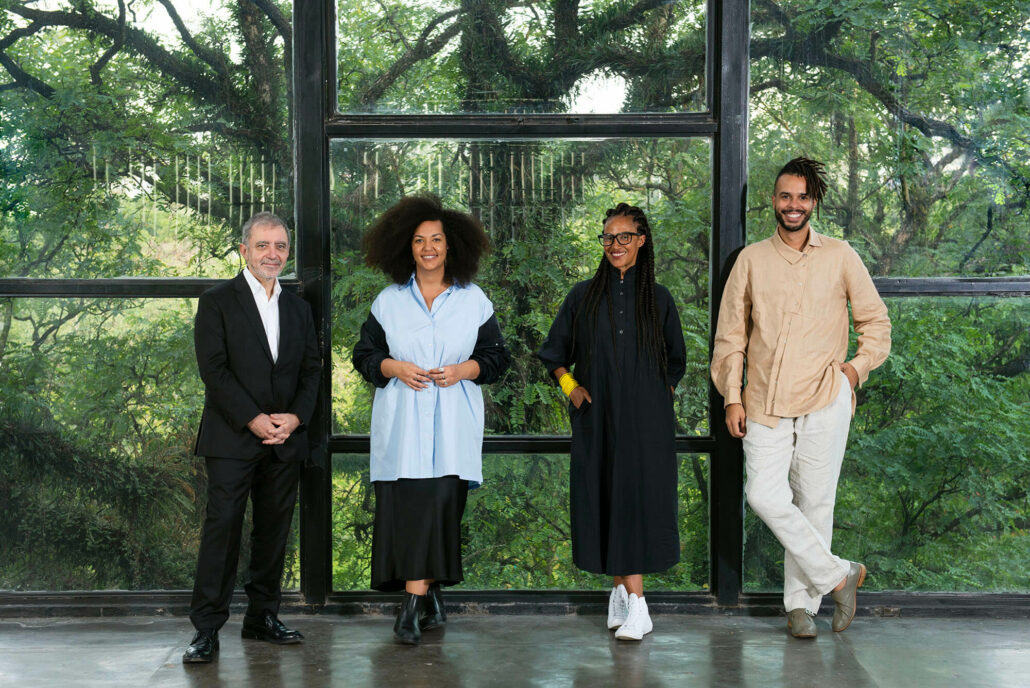
Curatorial collective of the 35th Bienal de São Paulo, from left to right: Manuel Borja-Villel, Diane Lima, Grada Kilomba and Hélio Menezes © Levi Fanan / Fundação Bienal de São Paulo
The title of the 35th edition of the Biennale de Sao Paulo,’ Choreographies of the Impossible,’ takes the viewer on a non-narrative path of exploration through the exhibition. The four curators, each influenced by their own curatorial training practice, have worked together in a horizontal manner to the theme of the Biennale. Diane Lima, Grada Kilomba, Hélio Menezes, and Manuel Borja-Villel used their respective knowledge and backgrounds to bring together this mammoth task. Working with curatorial assistants Sylvia and Tarcisio Almeida and the curatorial council, including Omar Berrada, Sandra Benites, Sol Henara and Thomas Lax, they embraced the inherent institutional and curatorial challenges.
The visual identity of the Bienal was designed by artist Nontsikelo Mtuti. She explains that the Bienal was conceived as a ‘”braid” of worlds urging the viewer to think about the journey and exploration of their visit and the navigation through the works by the 121 participants.
The architectural firm Vão, responsible for directing the architectural and exhibition design of the ‘choreographies of the impossible”, has designed a choreography of paths. The design is deliberately without themes or chronological order, encouraging a physical experience of flow shifts and interventions throughout the building. Significant elements like floor inversions and enveloping the central span, honour the integral aspect of architect Oscar Niemeyer’s original project when designing the Pavilion opened in 1954. The design flow influences movements, accelerating, slowing down, pausing, and suggesting various speeds, connecting diverse rhythms and contrasts beyond the monumental scale of the Pavilion.
One floor features closed rooms, filling the outer periphery of the void space, while on another, closed galleries occupy the central space, surrounded by an expansive, open area. This concept extends to the places of coexistence and encounter within the ‘Choreographies of the Impossible’ space. These design creates a dynamic and multifaceted environment.
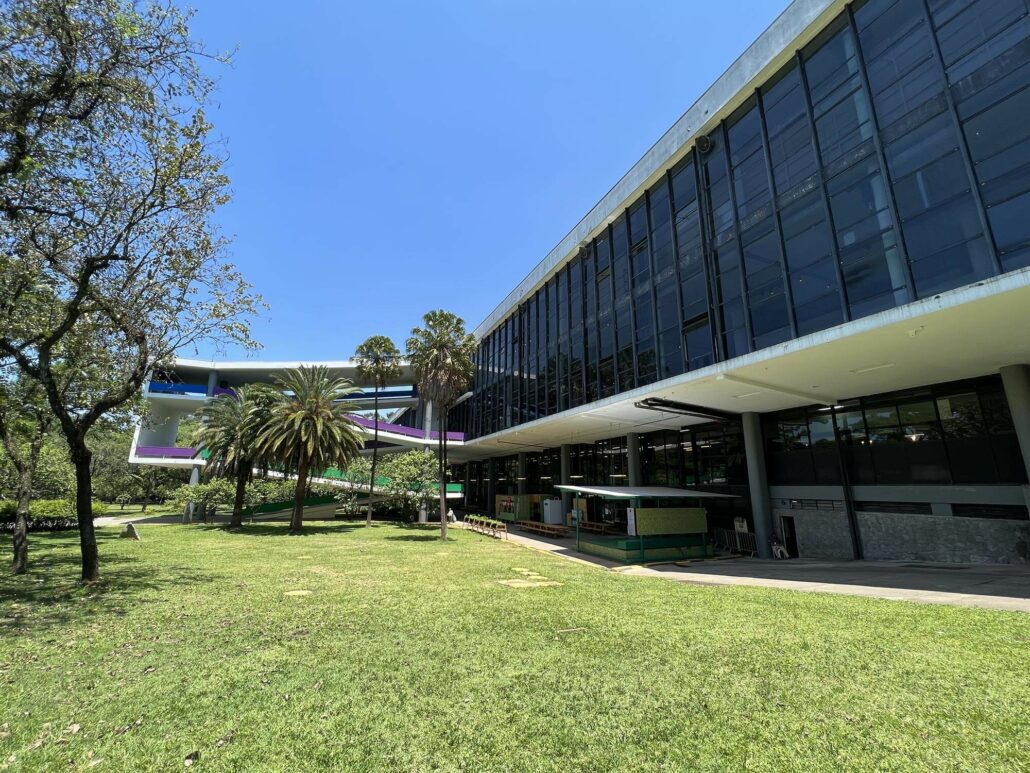
Exterior of Ciccillo Matarazzo pavilion. © Suzette Bell-Roberts.
The works presented at the 35th Bienal include art produced between the 17th century and 2023. However, their dialogue and relationship, propositions, and provocations exceed and invalidate such dates. The works presented are expressed in multiple languages, moving between cinema, visual arts, music, ritual art, dance, poetry, and other forms that defy conventional categorisation. Elusive spaces exist in native, existential, spiritual, and ancestral territories, where residents choreograph the impossible within their lived experiences. Here, individuals conceive their instruments, movements, and languages. These territories manifest in street protests, corners and crossroads, bridging written and visual language at the diverse intersections of geography and expression.
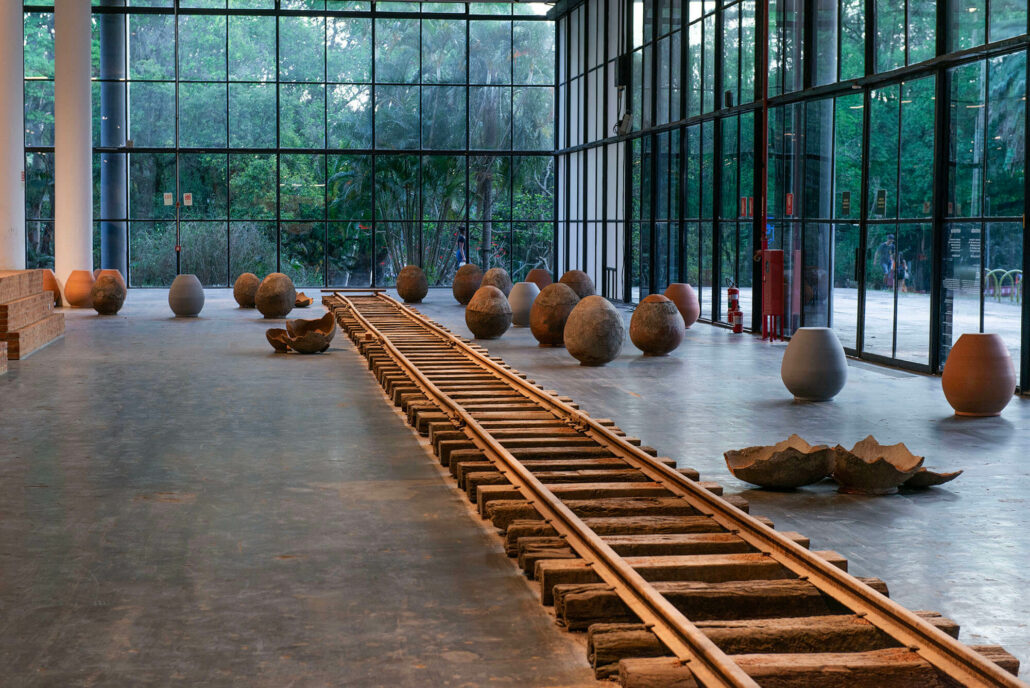
Installation view of Ibrahim Mahama’s work Parliament of Ghosts during the 35th Bienal de São Paulo – choreographies of the impossible © Levi Fanan / Fundação Bienal de São Paulo
Known for his expansive works, Ibrahim Mahama utilises materials and spaces to conceive alternative narrative possibilities from a conceptual perspective, interconnecting various historical moments. These intersections explore issues of production, exploitation, and social justice, exemplified in Parliament of Ghosts, a project commissioned for the Bienal. Upon entering the exhibition pavilion, visitors encounter a recreation of the bleachers from the inner courtyard of Mahama’s Red Clay Studio, functioning as a public space for exhibition, project development, and art education. The surrounding pots depict the artist’s archaeological work in his territory and a set of railroad tracks, symbolising the extraction routes established by the English, where the Red Clay Studio currently operates. Within this convergence of materials, layered meanings, and a space for dialogue and learning, Ibrahim Mahama invites participants to engage in a game involving critical revisionism and active participation.
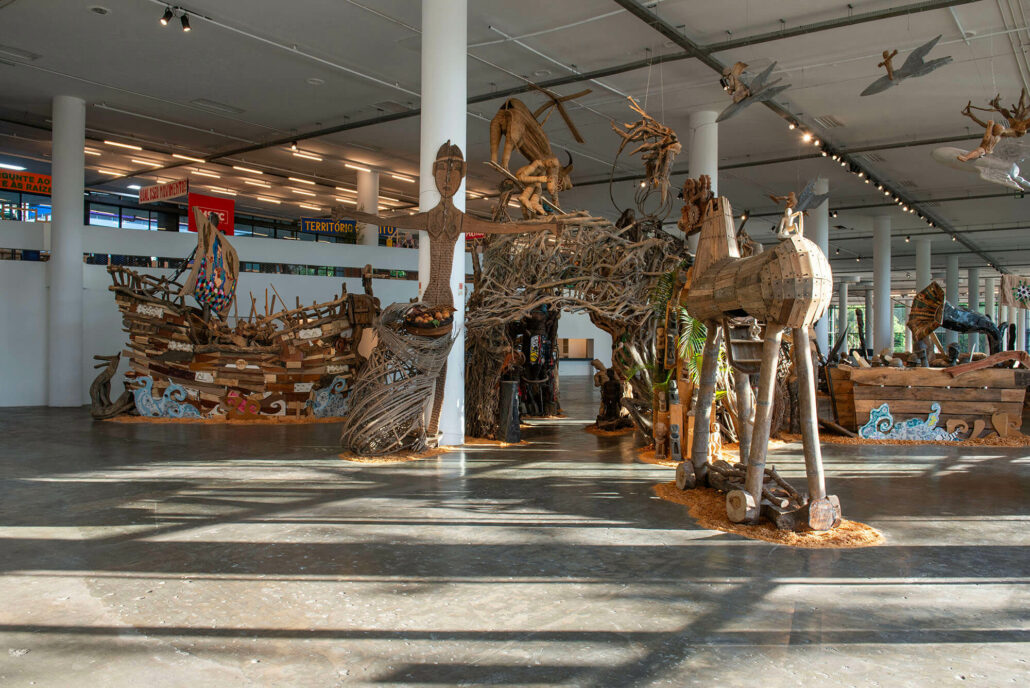
Installation view of Kidlat Tahimik’s work Killing us Softly… with their SPAMS… (Songs, Prayers, Alphabets, Myths, Superheroes…) at the 35th Bienal de São Paulo – choreographies of the impossible © Levi Fanan / Fundação Bienal de São Paulo
Kidlat Tahimik, approaching sculpting as a cinematic process, unveils the commissioned project Killing us Softly… with their SPAMS… (Songs, Prayers, Alphabets, Myths, Superheroes…) in collaboration with Filipino carvers. His three-dimensional wooden script crafts an environment where the cosmologies of Brazil’s native peoples and the Philippines intersect and clash amid ongoing neo-colonial exploitation, contributing to the genocide of forests.
“Igpupiara” in Tupi refers to the water-dwelling documented in Jesuit accounts from the 16th century, while “Shokoy” is the Filipino sea creature. The installation and its collage of images fabricate a fictional context wherein the coloniser Fernão de Magalhães intrudes upon the lives of Brazilian and Filipino indigenous communities, whose stories persist as narratives of resistance to this day.
The visual identity of the Bienal is the commissioned work of Nontsikelelo Mutiti. In her work, she conducts visual research on the broad vocabulary of hair braids as an expression of the African diaspora. Their political and aesthetic implications, in turn, are intertwined with notions of subjectivities as a decolonial practice. In the braids, their lives, returning, the creative pulse diluted in time. In this game of paths, Mutiti materialises a reflection on technology by analysing similarities between braiding and computer logic in her written work and her graphic gestures: repetition, braiding/interlacing, returns, modulation, and crossroads. It is a practice of abstraction that is also everyday life itself, densifying the perception of the texture of time in the interstices of interruptions, silences, and sequencing.

Exhibition view of the work of Rosana Paulino during the 35th Bienal de São Paulo – choreographies of the impossible © Suzette Bell-Roberts.
“Throughout the curation of the Bienal are several, even infinite, times at play: there is oneiric time, and its capacity for transmutation to access other planes and worlds, as told in Mari Hi (The Dream Tree), directed by Morzaniel Iramari; the ancestral time of mulheres mangue (mangrove women) by Rosana Paulino, powerful figures in form of roots and anthropomorphic trees, in which life, mud and renovation are indistinguishable; the telluric time of ceramics, unearthing stories of exploration but also of healing, as Marilyn Boror Bor and Simone Leigh teach us, or even M’barek Bouhchichi, in suppressing the distance between Dave the Potter’s verses, M’barek Ben Zida’s lyrics and Conceição Evaristo’s writings. There is the time-without time of those who live “in the time of capture,” as Stella do Patrocínio tells us in her ‘Falatorios’ the time that dwells on the hinge of re/memory with delirium, as Aurora Cursino and Ubirajara Ferreira tell us; the time of horror and its incarnate effects, about which narrative is impossible (but is still spoken of), as Ceija Stojka did.
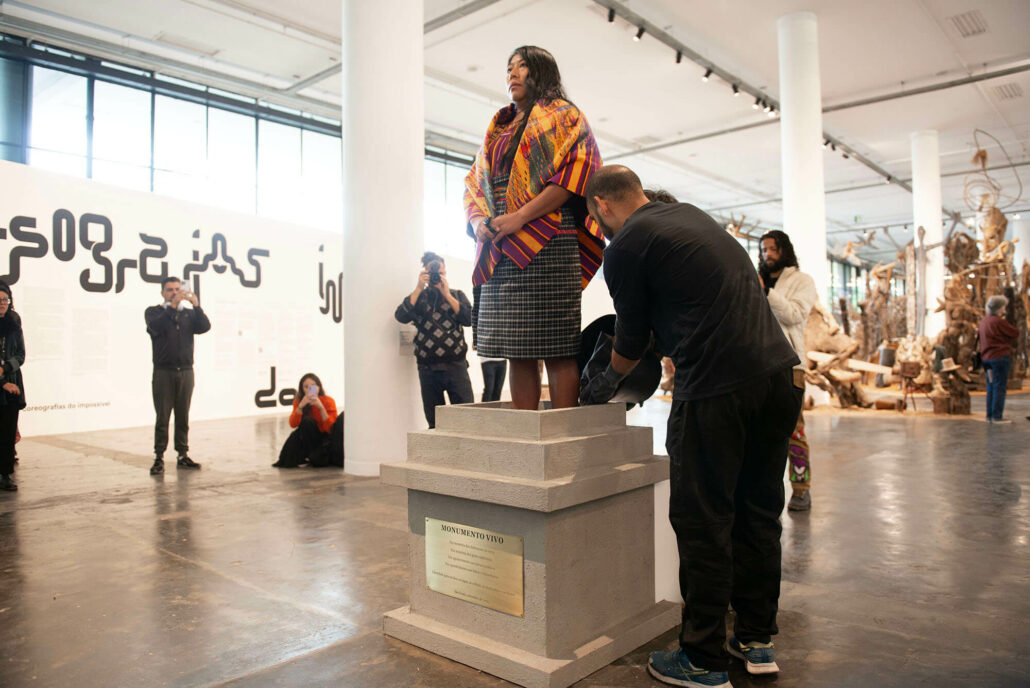
Exhibition view of the performance by Marilyn Boror Bor, Monumento vivo, during the 35th Bienal de São Paulo – choreographies of the impossible © Levi Fanan / Fundação Bienal de São Paulo
There is the time of a time that ends, as in the Silent March, organised by the Zapatista Army of National Liberation on 21st December 2012 – the day the world ended, according to the Mayan calendar. The slow time of sowing and the uncertain time of harvesting, set by the criollo corn garden, not subjectable to monoculture, which Denilson Baniwa explores in this Bienal; the time of re/de/composition of fungi, plants, and other beings beyond humans, in long-lasting cycles where life and death are indistinguishable markers, as Daniel Lie suggests.
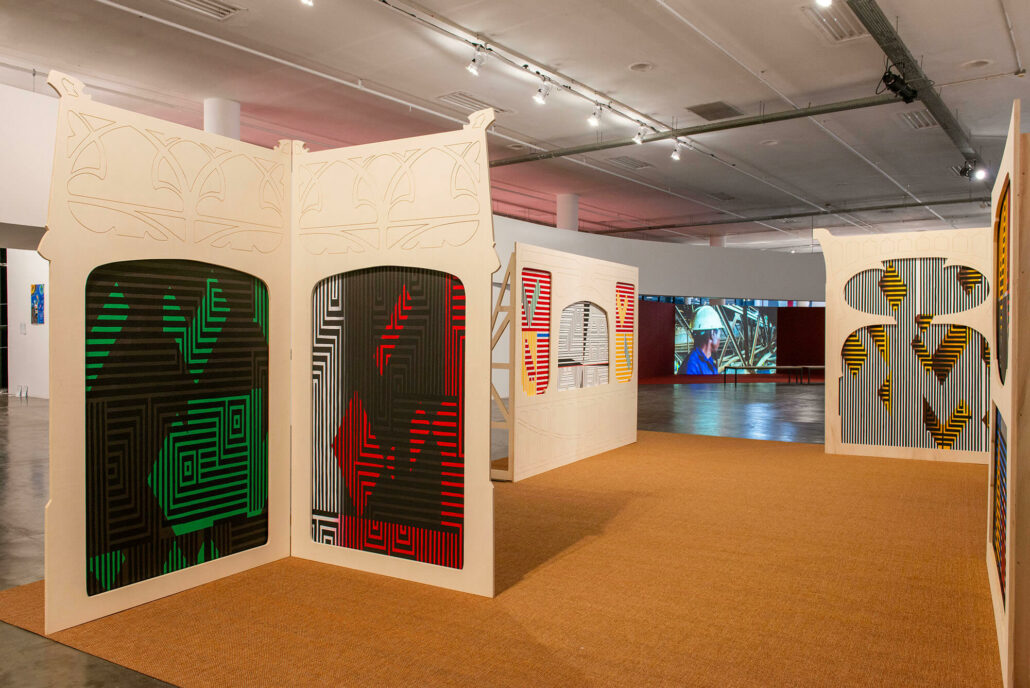
Exhibition view of the work of Sammy Baloji during the 35th Bienal de São Paulo – choreographies of the impossible © Levi Fanan / Fundação Bienal de São Paulo
There is the cumulative time of “found and unimportant objects,” collected throughout Rolando Castellón’s life in Nicaragua and Costa Rica; machinic time and dance, in its umbilical links with industrial colonialism-capitalism, which Warp Trance, by Senga Nengudi, Tales of the Copper Cross Garden: Episode I, by Sammy Baloji, and Sumidouro n°2 – diáspora fantasma (Sinkhole No. 2 – Ghost Diaspora0, by Laís Machado and Diego Araúja, seize and decode. There is the time of mourning and the (impossible, though inevitable) reconstruction of inter/rupted kinship ties, as in A água é uma máquina do tempo (Water is a Time Machine), by Aline Motta, which shuffles Afro-Atlantic colonial histories and family stories of death and self-writing; or as in Palestine under the gaze of Ahlam Shibli, populated by images of martyrs and murdered youth, on the street as well as in domestic spaces, portrayed in Death series.
There is the time of walking feet, of body shapes that go back and forth between Senegal, France, and Brazil, as choreographer Ana Pi points out, in partnership with Taata Kwa Nkisi Mutá Imê, chief priest of the Casa dos Olhos do Tempo que Fal (House of the Eyes of the Time that Speaks) – a candomblé terreiro whose name is already a proclamation of a time that is anything but static.” Hélio Menezes excerpt from the Bienal catalogue.
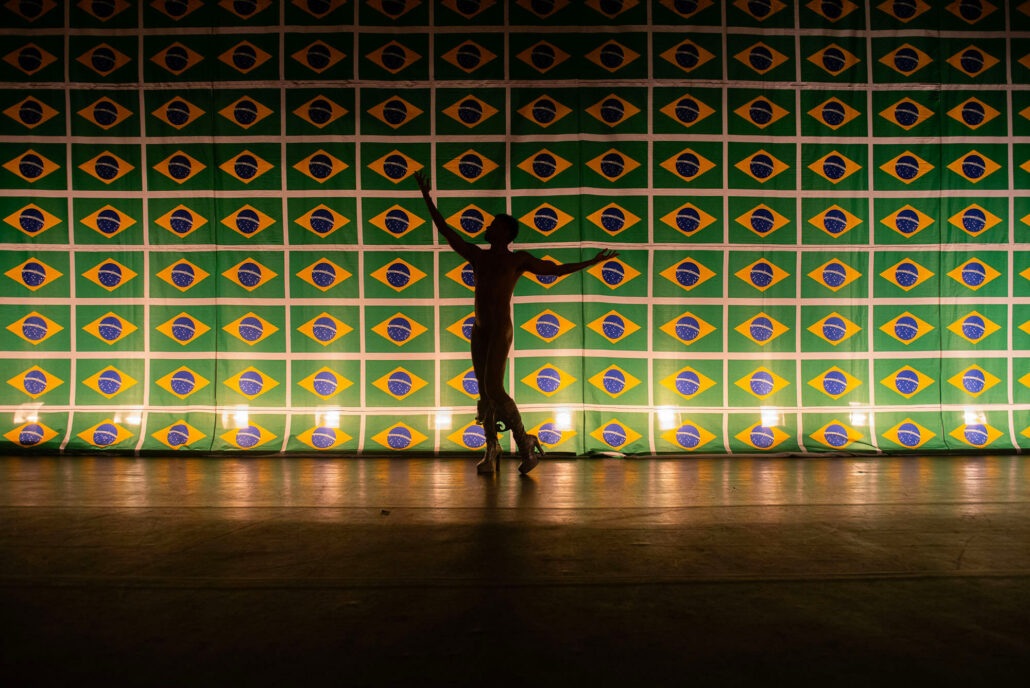
View of the performance O samba do crioulo doido, by Luiz de Abreu, performed by Calixto Neto at the 35th Bienal de São Paulo – choreographies of the impossible © Levi Fanan / Fundação Bienal de São Paulo
Artist-choreographers such as Bouchra Ouizguen, Luiz de Abreu, Will Rawls, Inaicyra Falcão, and the duo Davi Pontes and Wallace Ferreira employ the body as the central conduit of time. Their work encourages dialogues that traverse ancient and enduring connections among dance, music, and visual arts. Maya Deren’s camera, capturing Chao-Li Chi in a dance trance marked by precision, unexpectedly participates in the dance itself. Katherine Dunham’s rhythmic movements, bridging Africas, Caribbeans, and Americas, shape a choreographic vocabulary that continues to influence generations of artists, underscoring the complete interchangeability of time and body within this creative context.
Exploring artistic expressions from a curatorial perspective involves redefining the essence of choreography, going beyond its disciplinary history to embrace a poetic interpretation of time folds. This transformation challenges the assumed authenticity inherent in its lingual meaning, opening new perspectives on movements within an inherently irresolvable world. Improvisation and creativity become catalysts for innovative and unexpected motions.
‘Choreographing the Impossible’ means the social technologies and artistic practices that seek to evade the grammar of violence, referring to poetic exercises of resilience, social, aesthetic, and curatorial strategies of evasion from the norm. “A half-moon tempo, as they say in capoeiragem: the dexterity of combining an elusive manoeuvre, at the very moment of its realisation, with a reverse circular kick in a game that is also a dance, a dance that is also a fight. “Alongside defeat and terror, there would also be this: the glimpse of beauty, the instant of possibility,” Saidiya Hartman, a professor at Columbia University, says.
The illusion of unrestricted wandering or dancing bears a sombre undertone in these times of stark clarity. This modernity-coloniality, originating from transatlantic trafficking, forced displacements, border regulations, racialised spatial divisions, concentration camps, refugee crises, policies affecting sexual and gender dissent, land disputes, and the irreversible repercussions of environmental racism, collectively portrays a bleak aftermath—a world in agony.
Choreography encourages reflection on the risk of dancing freely, as it can be usurped by personal control of rebellious movements. This danger is evident in hierarchical interpersonal dynamics shaped by social factors such as race, class, gender, and sexuality, as well as by entities like the State and Capital, along with their surveillance and control institutions, especially within the domain of art.

Manuel Chavajay, Oq Ximtali, 2017/2023. Digital Photograph, 91 x 61cm. Courtesy of the artist.
Manuel Chavajay’s video performance captures a community action related to his concern about a specific location. He invited a group of fishermen to tie up their traditional boats, cayucos, while rowing in the translucent waters of the lake. The recorded image, captured by a drone, forms an almost perfect circle with twenty boats carrying various resources and symbolic objects, either flowing with water currents or exerting opposing forces.
After the act, the artist suggested to the participants that they could untie themselves, move freely, or coordinate to return together to the shore, leading to a moment of confusion. In Tzutuhil, Oq Ximtali translates to “they have us tied up” or “we are tied up.” This action explores and revives community dynamics threatened by the interference of opposing cultures. Chavajay’s work reflects an intense sense of historical pain alternating with hope, a mingling of fear and resilience, and the robustness of labour on land and water intertwined with vulnerability. Oq Ximtali conveys the recurring feeling of impossibility that has become a prominent aspect of the present, challenging the balance of communities, human relationships, and interspecies connections.
These choreographies of the impossible unfold in the inconceivable territory of Brazil. In the four years leading up to the 35th Bienal, 570 Yanomami children succumbed to mercury poisoning, malnutrition, and hunger in this country, as reported by the Ministry of Indigenous Peoples. Amid the infinite impossibilities that unfold daily in this place, this stands out, echoing the re-enactment of the 17th-century European invasion—a timeless loop. As Gilberto Gil sings: “here is the end of the world.”
The urgency and persistence of these issues prompt the ‘choreographies of the impossible’ to spotlight a diversity of artists, collectives, historical figures, collections, poets, and social organisations. Driven by the radical possibility, as Denise Ferreira da Silva proposes, of “thinking the world Otherwise,” they create between spaces and between times. Though transitory, these spaces are fertile grounds for generating and transmuting life. They align with the “ethical mandate to challenge our thinking, free our imagination, and welcome the end of the world as we know it, that is, decolonisation, which is the only adequate name for justice,” in Denise’s terms. The elusive spaces exist in native, existential, spiritual, and ancestral territories, where residents choreograph the impossible within their lived experiences. Here, individuals conceive their instruments, movements, and languages. These territories manifest in street protests, corners and crossroads, bridging written and visual language at the diverse intersections of geography and expression.

Installation view of Samesyn, by Igshaan Adams during the 35th Bienal de São Paulo – choreographies of the impossible © Levi Fanan / Fundação Bienal de São Paulo
Igshaan Adams’ works involve performance, weaving, sculpture, and installation, in which he uses materials such as beads, wire, linoleum, cotton threads, copper wires, fabric, etc., which are elements that relate to his memories and cultural and religious references. Adams builds his poetics based on political and social issues surrounding him, especially concerning the geography of his hometown, whose boundaries and inhabitants were delimited and grouped by the Apartheid segregationism of the 1960s.
In Afrikaans, Samesyn means togetherness. The installation presents a large abstract map formed by a piece of tapestry that acquires texture, volume, and colour from a complex mixture of locally sourced materials. The tapestry map is crossed by a ‘line of desire’, an in-between space that alludes to the borders of racial segregation and is activated by the visitor who moves freely through it. Clouds of dust hover over the lines of desire like those that form in the fields where the ‘Riel’ is danced – a traditional dance in which feet move lightly and have now been taken up by new generations.
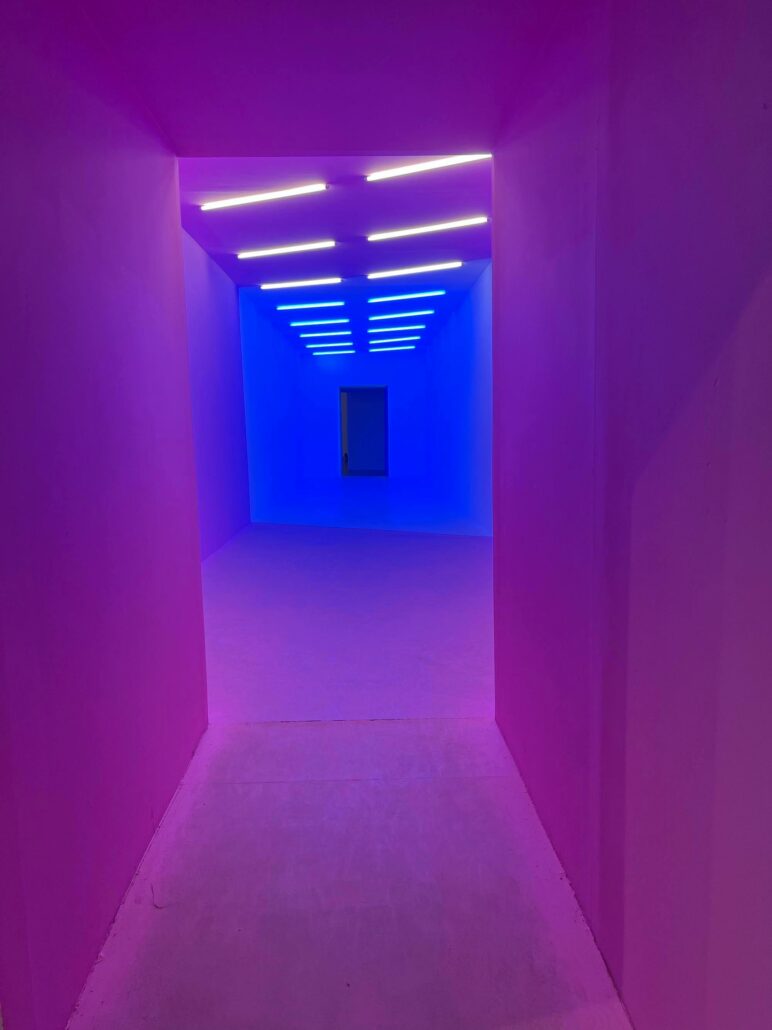
Installation view of Kapwani Kiwanga during the 35th Bienal de São Paulo – choreographies of the impossible © Levi Fanan / Fundação Bienal de São Paulo
Kapwani Kiwanga’s multiple media works include installation, sculpture, photography, video, and performance. These “languages” are always considered in the artist’s research, which touches on marginalised histories, power asymmetries, and historical (counter)narratives – especially the effects of coloniality in the Americas.
In this play of symbolic criticism and the imagination of possible futures, the installation of pink-blue invites us to live with colour in its material state. This materiality, in turn, is that of disciplinary architecture itself. Buildings designed to impact and control human behaviour in public spaces or institutions. The use of pink appeared in the prison systems of the 1970s and was designed to reduce aggression and conflict among inmates; blue, a luminous colour, was intentionally used in public bathrooms to reduce the visibility of veins and supposedly reduce the use of injectable drugs – which statistically increased the risk of dangerous injections. Pink-Blue summons us to an interdisciplinary displacement, from one state to another, from one matter to another.

Taller 4 Rojo, Agresión del imperialismo a los pueblos, A la agresión del imperialismo: guerra popu- lar, Vietnam nos señala el caminho (Imperialism’s Aggression Against Peoples, to Imperialism’s Aggression: People’s War, Vietnam Shows Us the Way), 1971-1972. Silkscreen print, 100 x 216,6cm. © Taller 4 Rojo
At the beginning of the 1970s, Taller 4 Rojo articulated a critical vision, carried out actions directly and supported social movements under the National Front governments. This Liberal and Conservative parties coalition resulted in one of the most authoritarian periods in Colombia, with open violation of human rights, as well as consolidated the armed conflict in the country. In this context, the Taller 4 Rojo founded a popular school and conducted fieldwork with peasant and indigenous communities, trade unions and marginalised urban sectors, documenting their experiences. These records, together with images collected from the press, were the testimonial substance that they transfigured through operations taken from the graphics and the Latin American cinema of the time, such as montage, the production of series and sequences, and the work with patterns and high contrast. Posters such as A la huelga 100 a la huelga 1000 (100 to the Strike 1000 to the Strike) (1978) were made along several years of collaboration with independent trade unionism.
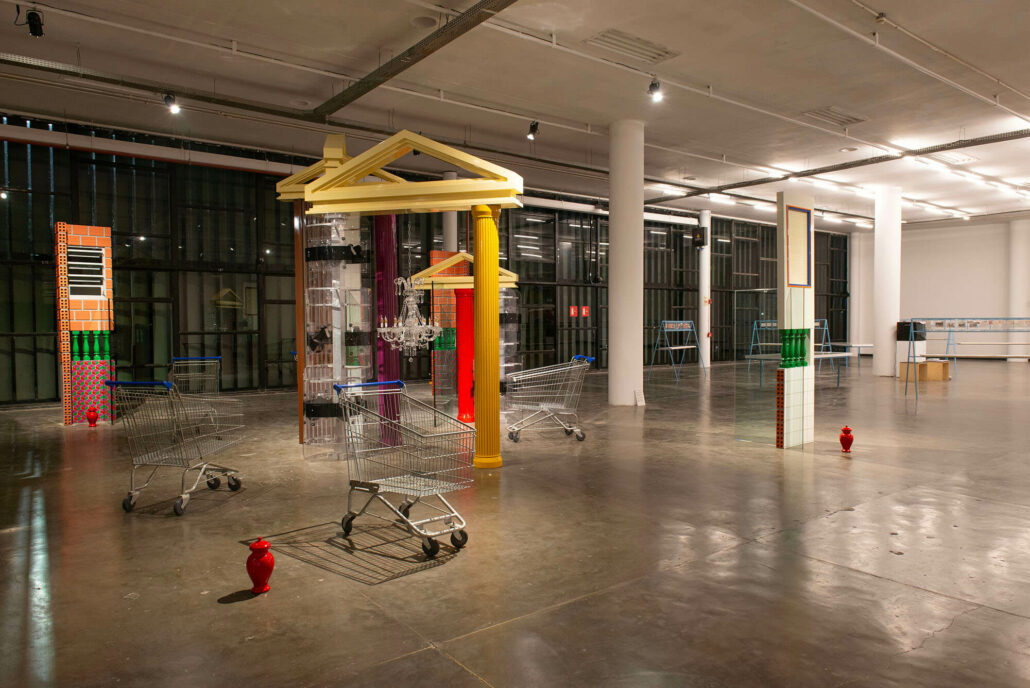
Installation view of Rommulo Vieira Conceição’s work O espaço físico pode ser zona de disputa, convenções e certezas falíveis during the 35th Bienal de São Paulo – choreographies of the impossible © Levi Fanan / Fundação Bienal de São Paulo.
Based on reflections on the concepts of place and space, Rommulo Vieira da Conceição explores the relationships between the body, objects, and constructions in urbanisation and the public and private spheres. Always taking a critical perspective, his projects reinterpret the structures and political layers of spaces and propose, in three-dimensional abstraction, symbolic and functional displacements.
In the installation commissioned for the 35th Bienal, the artist studies the contradictions of architectural structures observed in low-income urban areas (Favela Nova Jaguar, in São Paulo, Favela Santa Maria, in Rio de Janeiro, and Bairro Humaitá, in Rio Grande do Sul) and juxtaposes objects from everyday life that are often marked by both the legacies of colonialism and state violence – such as Military Police riot battalion shields and supermarket trolleys.
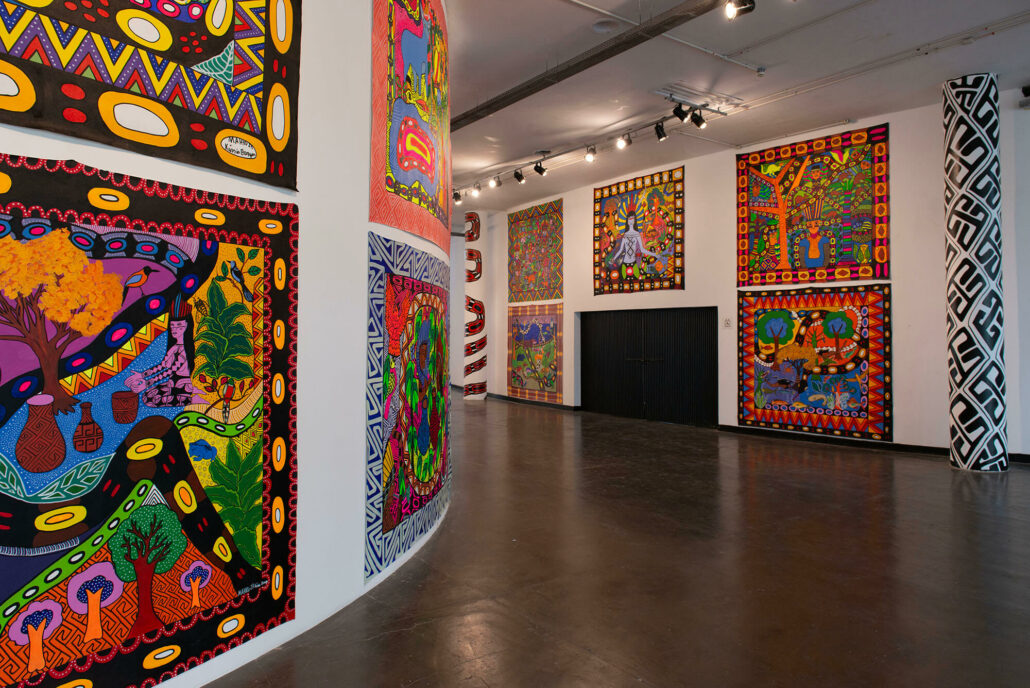
Exhibition view of the work Rewe Rashūiti of MAHKU during the 35th Bienal de São Paulo – choreographies of the impossible © Levi Fanan / Fundação Bienal de São Paulo
MAHKU is short for Movimento de Artistas Huni Kuin (Movement of Huni Kuin Artists). A collective made up of the artists Acelino Huni Kuin, Ayani Huni Kuin, Bane Huni Kuin, Batani Huni Kuin, Cleudo Huni Kuin, Nawa Ibä Neto Huni Kuin, Ibä Huni Kuin, Kássia Borges Karajá, Isaka Huni Kuin, Leone Huni Kuin, Maná Huni Kuin, Rare Huni Kuin, Rita Huni Kuin, Tene Huni Kuin, and Yaka Huni Kuin. Formed in the late 2000s, Ibä Huni Kuin and his sons Acelino, Bane, and Mana began offering painting workshops to preserve and pass on their community’s songs, traditional practices, and mythology to new generations.
The collective’s artistic practice is also an imagistic translation of the Huni Meka chants. These sacred chants are sung during the Nixi Pae, or vine ritual, and narrate mythologies and stories that structure Huni Kuin cosmology concerning forest beings. The group’s motto, “sell the canvas to buy land”, points to a forceful and radical activism of cultural recognition that aims to emphasise the tactics of preserving and maintaining traditional lands. For the 35th Bienal, we find a large-scale panel painting produced from extensive collective work involving learning, healing, and transformation; ethical premises are always present in MAKHU’s actions.
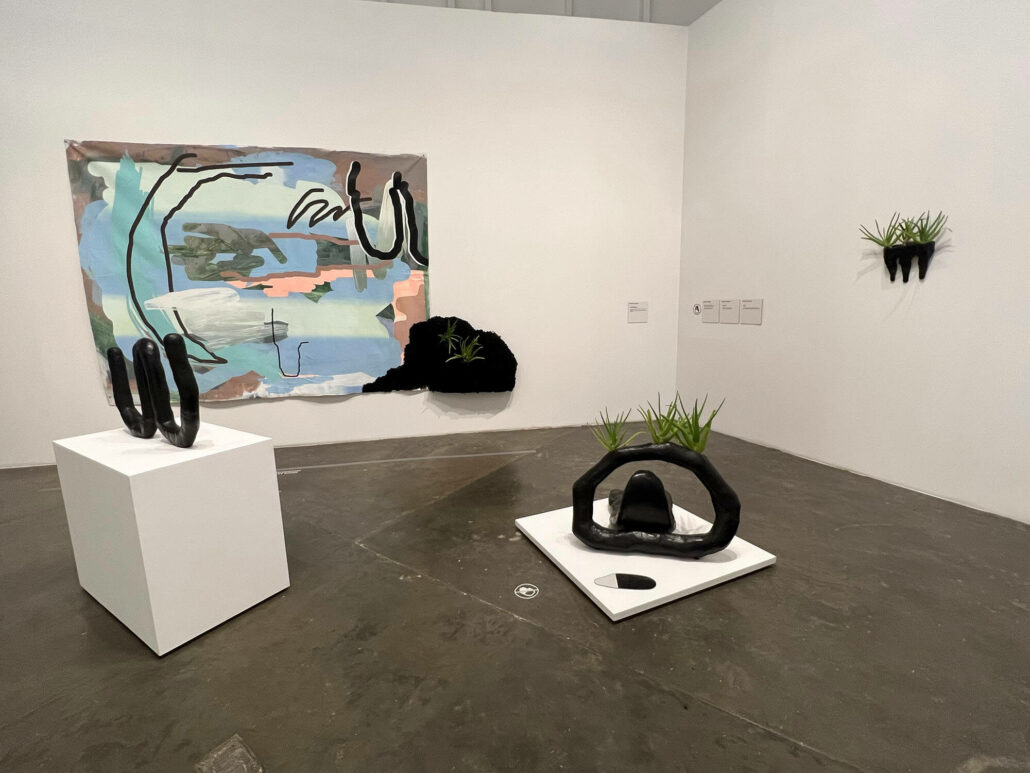
Installation view of the work of Deborah Anzinger during the 35th Bienal de São Paulo – choreographies of the impossible © Suzette Bell-Roberts.
Deborah Anzinger works with painting, sculpture, video, installation, and building projects that question and reposition the visual/discursive syntax that relates us to the land from a race and gender perspective. Inviting us to think about the relationships produced by language, its paradoxes, contradictions, and urgencies, Anzinger’s works are conceptually grounded by their materials. In the artist’s universe, forms always seem to unfold into others, converting landscapes into parts of the body, death into life, and metaphors into form. This game aims to destabilise the binary modes of recognising the earth and subjectivities in favour of an abstract, challenging, and compositional path. The hybridity of materials, such as aloe vera, mirrors, and locks of curly hair, increases in the compositions, forcing the painting out of its two-dimensional field. They evoke healing properties and politically position the artist’s practice by presenting an expanded perspective of the Caribbean outside of socio-visual predicaments and expectations, emphasising a commitment to vitality despite all odds and improbable births.

Cabello/carceller, A Voice for Erauso. An Epilogue for a Trans Time, 2021-2022. © Levi Fanan / Fundação Bienal de São Paulo
Since their emergence on the contemporary art scene in the mid-1990s, the work of Helena Cabello and Ana Carceller has questioned the devices and conventions of the representation of sexualities and identities outside the norm. In Una voz para Erauso.Un epílogo para un tiempo trans (A Voice for Erauso. An Epilogue for a Trans Time) , the artists bring the complex biography of Antonio de Erauso to the present.
Known as “The Nun Ensign,” he was a character from the Spanish colonial baroque famous for having managed to circumvent the gender binarism imposed on the bodies of the Empire.
The work develops in a game of distancing that weaves a queer and almost hauntological’ temporality. Four centuries later, three non-binary trans people question the portrait of the ensign and, through old, a fundamental issue: the right to be named. However, far from creating a new queer hagiography, the protagonists build up the narrative and expose its dark areas:
Erauso’s confessed racism, his participation in the Mapuche genocide, the high levels of violence that permeate his history. Thus, Cabello/Carceller expose several strategies that delve into key aspects. The first is that every portrait is always performative. The second, as Paul B. Preciado explains, is that the figure of Erauso is a discursive and visual territory in dispute, a place “where a multiplicity of conflicting identities is constructed and deconstructed” In a historically dense queer gesture, Cabello and Carceller outline dissident counter-images on the margins. Whether at a glance or through connotations, these footnotes reveal elusive, discontinuous, and bastard genealogies.
Another addition to van der Hamen’s oil painting is An Una voz para Erauso. ‘Un epilogo para un tempo trans’, Cabello and Carceller’s words and scenes challenge the integrity of the hegemonic and make art a tool to address the ever-flickering horizon of subjectivities that lie ahead.
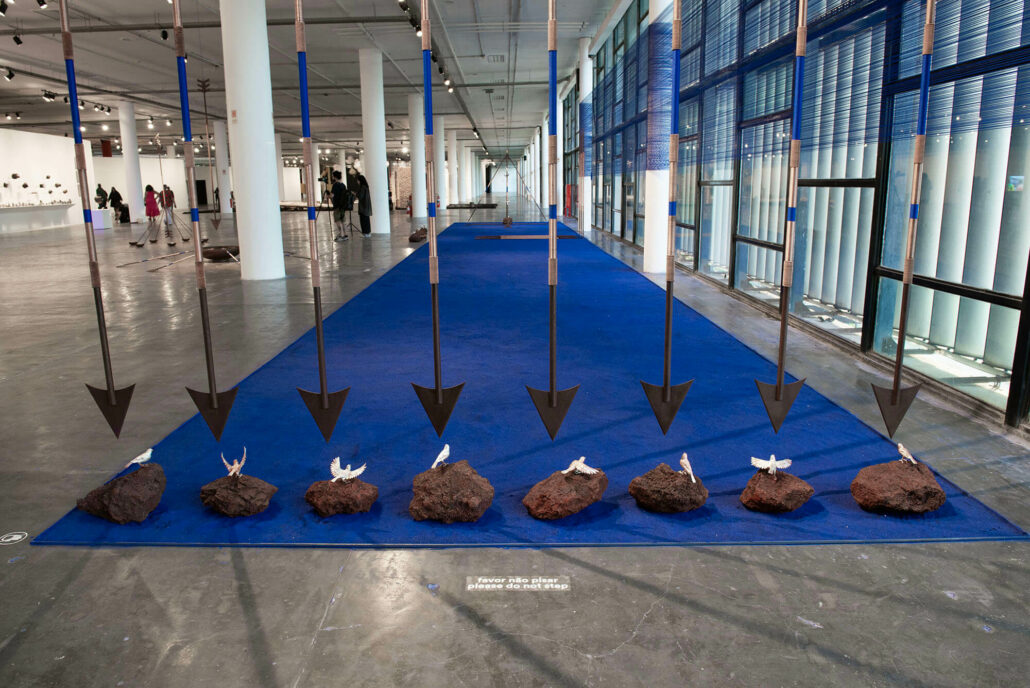
Installation view of Luana Vitra’s work Pulmão da mina during the 35th Bienal de São Paulo – choreographies of the impossible © Levi Fanan / Fundação Bienal de São Paulo
One of the subjects of Luana Vitra’s research is telling oral stories. She grew up listening to accounts from relatives involving everything from Afro-diasporic celebrations, knowledge, and technologies to the traumas of the slave-owning past of the Ouro Preto region, where her family lives. A constant theme is the stories that involve the legacy of centuries of extractive economies promoting local ecosystem degradation. Vitra remembers hearing about enslaved people who used to take canaries with them to work in gold mines. With its incessant singing and accelerated metabolism, this bird was used as a sentinel.
Its lungs reacted in an instant to the presence of toxic gases emanating from mineral extraction, and its silence was the warning for miners to open paths to escape the galleries, avoiding the dangers of lethal intoxication. The survival of those people meant the death of the birds, mirroring how slavery not only devastated human lives but extended its terror over other species. The main element of the installation is arrow amulets intended to unblock paths. Made of iron, an archetypal material of recurrent use in her works, they act as conductors, pointing to places of prosperity where “possibility prevails.” Some of these are grouped and positioned diagonally towards each other at the centre of the installation. This composition creates a path referencing the meanings and possibilities that each grouping carries. Copper gourds, birds bathed in silver and copper, metals of a highly conductive nature, and indigo powder, a substance often used for energy cleansing, are included in the installation.

Exhibition view of the work of Yto Barrada during the 35th Bienal de São Paulo – choreographies of the impossible © Levi Fanan / Fundação Bienal de São Paulo
Multimedia artist Yto Barrada’s practice considers the structures of official narratives defined in the geopolitics of colonisation, emphasising the prevalence of fiction that constitutes discourses and borders. Politics and contradictions of modernity, appropriations, and undermining stereotypes populate the artist’s horizon. Still, the seriousness of the themes is often distilled by the playful content obvoluted in her research.
The project commissioned for the 35th Bienal continues the ironic provocation present in previous works that play with the idea of the ludic nature of building blocks while resizing, at the same time, the toys and the values that underlie the symbolic negotiations engendered in modernist architecture and operated by the idea of French progress in Morocco. Play is taken seriously in the artist’s work because it leads us to a key to sophisticated experimentation of contravention and disobedience.
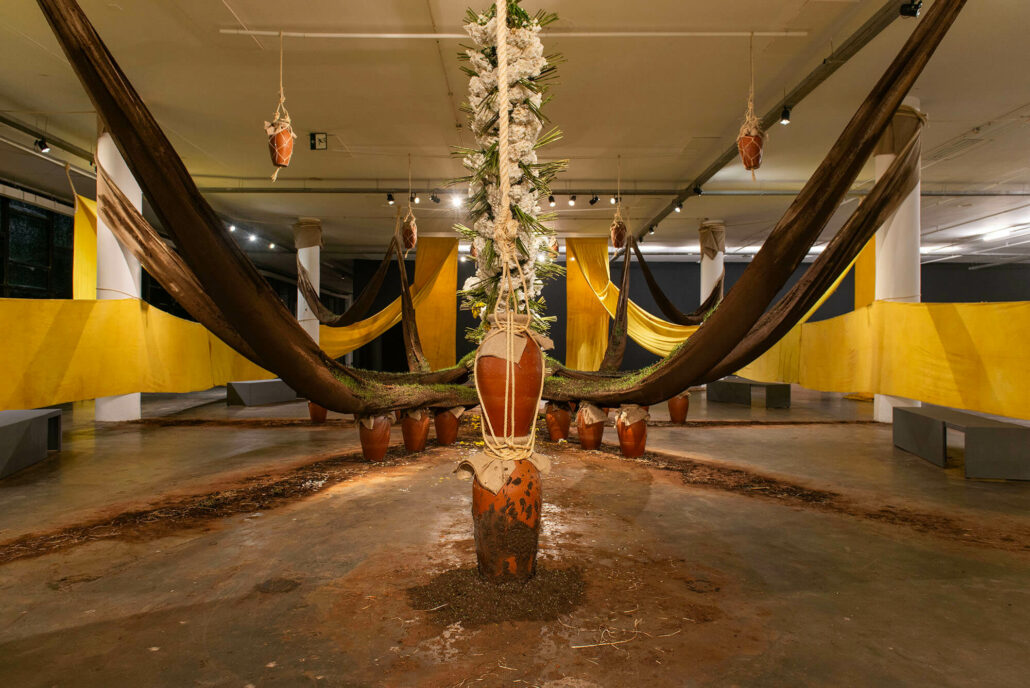
Exhibition view of the work Outres, by Daniel Lie during the 35th Bienal de São Paulo – choreographies of the impossible © Levi Fanan / Fundação Bienal de São Paulo
Daniel Lie’s installation, sculptural, and performative projects are always realised in collaboration with ‘beyond-human’ forces, such as bacteria, fungi, plants, animals, minerals, spirits, and ancestors. In this dialogue, they investigate a profound relationship between spirituality and science from dilated temporalities that break or question human protagonism as the absolute metric of life.
In the project Outres, an installation commissioned for the 35th Bienal, Lie creates a co-participatory relationship. This space-time brings together several compositional moments that permeate the years of production of production: terracotta vases, columns, and arrangements of yellow and white chrysanthemums, as well as cotton fabrics dyed with turmeric. The effects of the passage of time are also agents here, prioritising a space of silence. New lives derived from the materials made and remade, that decompose and sprout, announce an ethical position that disconnects from the binary reading between life and death and disentangles the linearity of time. This methodology was developed to be applied in other communities and other peripheries.
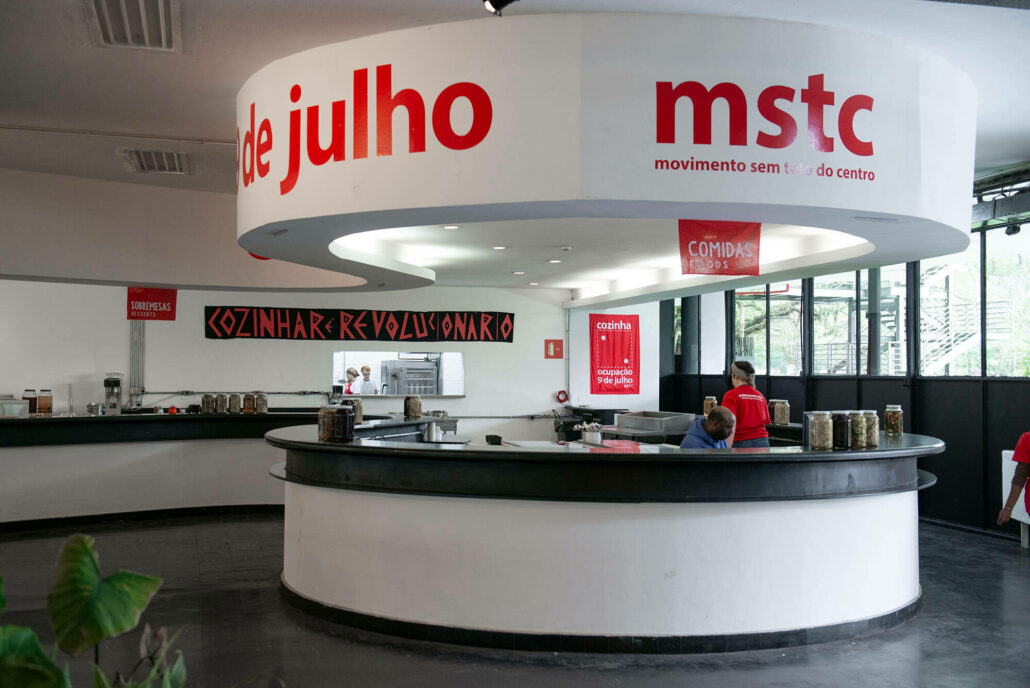
Exhibition view of the work of Cozinha Ocupação 9 de Julho – MSTC during the 35th Bienal de São Paulo – choreographies of the impossible © Levi Fanan / Fundação Bienal de São Paulo

Image – The restaurant ‘Cozinha Ocupação 9 de julho – MExhibition view of the work of Cozinha Ocupação 9 de Julho – MSTC during the 35th Bienal de São Paulo – choreographies of the impossible © Levi Fanan / Fundação Bienal de São PauloSTC’
Born from the dynamic of a building occupied by almost five hundred people of the Movimento dos Sem Teto do Centro (MSTC) (Homeless Movement of the City Center), the Cozinha Ocupação 9 de Julho (Kitchen of the 9 of July Occupation) has been operating since 2017. The movement is a vast multidisciplinary network with redistribution policies, zero waste, and a deep concern for food security. It is a space that goes beyond the preparation and consumption of meals. It represents the strength of solidarity and the power of collective work around issues such as the right to the full use of urban space. With regularly held lunches open to the public, the Kitchen has brought greater visibility to the struggle for housing in São Paulo. It promotes the social use of spaces relegated to real estate speculation and protects against eviction. The strategy of opening the movement reinforces the work of the Occupation and allows the social technology developed to be applied in other communities and peripheries.
“Occupying is caring,” a phrase in all the spaces of the Kitchen, is both a guideline for the MST’s relationships and the preparation of meals. Empathy and affection are the engines that drive the work.
The Kitchen works in partnership with other housing movements, social organisations, and the artistic class, becoming an important cultural centre and an active meeting place for activists, intellectuals, artists, and political leaders. This new angle strengthens the MST’s connections with the city and directly responds to attacks by the media and established powers keen on criminalising social struggle.
This way of choreographing survival strategies in a megalopolis like São Paulo is significant for the 35th Bienal, inspired by the Kitchen and its always collective, horizontal form of organisation, dreaming the impossible, creating bridges within the framework of im/possibilities.
The choreography of survival strategies in São Paulo, exemplified by The Kitchen, holds particular significance for the 35th Bienal. Inspired by its collective, horizontal organisational model, the Bienal dreams the impossible and creates bridges within the framework of possibilities and impossibilities.
The Fundação Bienal de São Paulo serves as a dynamic institution, not confined to the São Paulo Biennial alone. The Foundation is engaged in year-round artistic, educational, and social initiatives. Operating in an emblematic Brazilian modernist architecture pavilion, the Foundation is politically and religiously unaffiliated, seeking to stimulate fresh ideas, ignite debates, and cultivate a discerning public eye with a constant sense of restlessness, purpose, and inquiry.
The extensive public program of ‘choreographies of the impossible’ includes activations, performances, roundtables, talks, film screenings, workshops, and laboratories throughout the exhibition. The core questions revolve around what these practices, originating from diverse locations, can generate when placed in dialogue. The Foundation believes that addressing these questions contributes to inventing and discovering new choreographies, fostering ruptures, encounters, consensuses, and dissensuses. This approach underscores the central role of platforms like biennials in shaping formative processes and research and strengthening collective movements. The way the team narrates its path in the three movements – the name given to the educational publications that complement each other and reveal themselves throughout the construction of choreographies of the impossible – is also an excellent example of how the concept radiates.
Through the creation of a broad educational program and invitations to different artists and researchers, the team understands that other educational procedures are devices of liberation and freedom, if not a calling in which artistic, intellectual, and political practices become fundamental in the construction of knowledge based on exchange, collaboration, and experimentation.
The São Paulo Bienal ran from the 6th of September until the 10th of December, 2023. The complete list of artists announced so far can be found on the São Paulo Bienal website.
Suzette Bell-Roberts is Co-founder and Digital Editor of ART AFRICA magazine.

